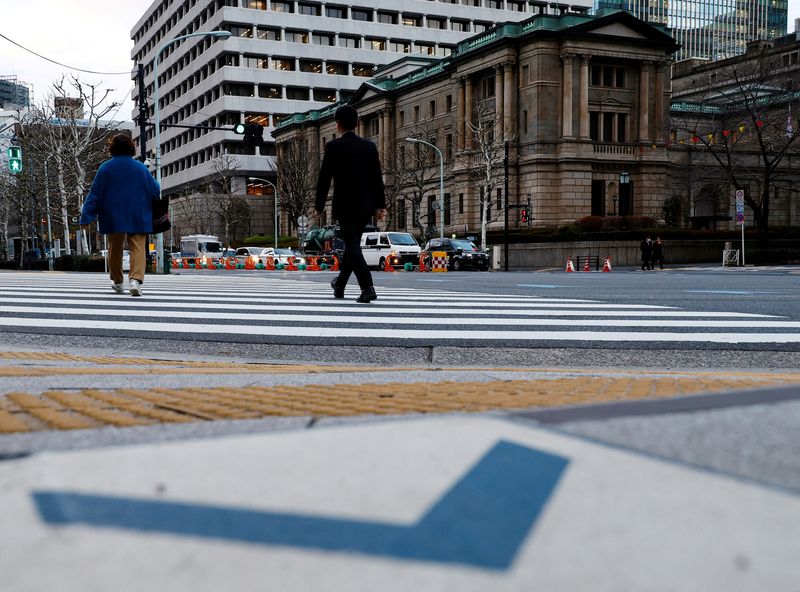Factbox-What would the BOJ’s stimulus exit look like?

People walk in front of the Bank of Japan building in Tokyo, Japan January 23, 2024. REUTERS/Kim Kyung-Hoon/file photo
By Leika Kihara
TOKYO (Reuters) – Prospects of strong wage hikes this year have heightened the chances the Bank of Japan will phase out its massive monetary stimulus in what would be a landmark shift away from its decade-long stimulus programme.
Below are the key tools that make up the central bank’s complex stimulus framework, and what will likely happen to them when the BOJ decides to exit from ultra-loose policy:
NEGATIVE INTEREST RATE POLICY
Since 2016, the BOJ has been applying a 0.1% charge on a small pool of excess reserves financial institutions park with the central bank. By doing so, it guided short-term borrowing costs slightly below zero. The move was also aimed at prodding banks to lend out money instead of hoarding it in accounts.
Upon an exit, the BOJ will instead pay 0.1% interest to the excess reserves financial institutions park with the central bank to mop up some cash from the economy. With the move, the BOJ will guide the overnight call rate, which will be its new policy target, in a range of zero to 0.1%.
YIELD CURVE CONTROL
The BOJ sets a 0% target and a loose ceiling of 1% for the 10-year government bond yield under yield curve control (YCC), a policy put in place in 2016 to prevent excessive falls that flatten the yield curve and crush investors’ margin.
The central bank will dismantle YCC but offer some language reassuring markets that it will keep buying enough government bonds to avoid any abrupt spike in bond yields.
Several ideas are being discussed on the exact wording of the commitment. The most likely option is to commit to buying government bonds around the current pace for the time being, or promise to intervene with huge buying upon sharp yield rises.
It will eventually start slowing bond buying and hold off reinvesting proceeds from bonds that reach maturity, to scale back the size of its huge balance sheet.
RISKY ASSET BUYING
The BOJ began buying risky assets such as exchange-traded funds (ETF) and real estate trust funds (REIT) in 2010 as part of a stimulus programme deployed under former governor Masaaki Shirakawa.
The central bank ramped up buying several times through to March 2021, when it decided to step in with purchases only in times of huge market turbulence.
While the BOJ’s ETF buying underpinned stock prices, it has drawn criticism for distorting market pricing and crowding out private investors. Unlike government bonds, ETFs do not have maturity and therefore won’t fall off the BOJ’s balance sheet unless the central bank sells them in markets to a third party.
Given such side-effects, the BOJ will likely discontinue such risky asset purchases upon an exit from ultra-easy policy.
FORWARD GUIDANCE
The BOJ pledges to maintain its massive stimulus programme “for as long as necessary to stably achieve” its 2% inflation target. It also promises to ramp up stimulus as needed, and keep expanding base money until inflation stably exceeds 2%.
All these commitments are likely to be removed. But the BOJ will offer guidance pledging to keep monetary conditions accommodative for the time being, to reassure markets that it will not shift to a steady rate-hike path of the kind seen in the United States and Europe.
The BOJ has said Japan’s inflation expectations have yet to be anchored at 2%, and that there are uncertainties on whether the solid wage increases seen this year will continue. This means it will likely take a wait-and-see approach before raising rates again.







